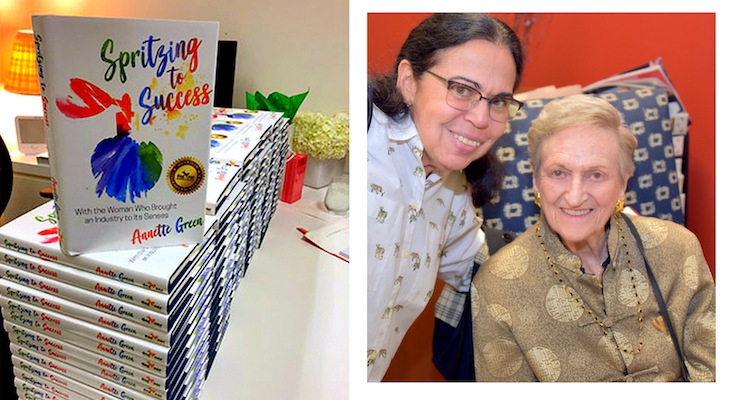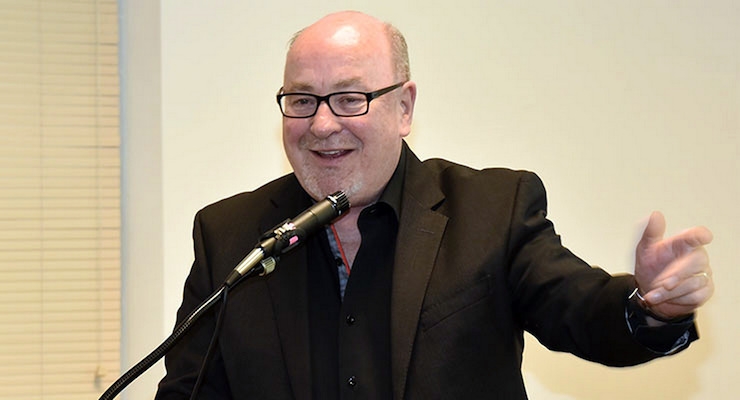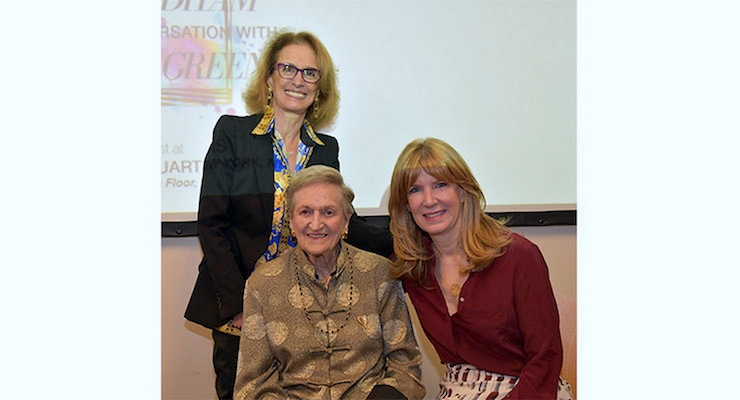Nancy Jeffries, Contributing Editor10.11.18
Annette Green, former president of The Fragrance Foundation (TFF), and a truly unique voice in the fragrance industry, shared her inspirations and philosophy during a conversation with two retail industry legends:
- Rose Marie Bravo, former CEO of Burberry and former president of Saks Fifth Avenue
- Kate Oldham, Saks Fifth Avenue’s senior vice president and GMM
Green is the author of Spritzing to Success, a chronicle of the life and times of a business trailblazer and role model for women around the world.
Here's what happened—read on.
Don Loftus, former chairman of the board, The Fragrance Foundation, welcomed attendees. Bravo began the discussion with a look at the sources of Green’s fragrance inspirations and acknowledged her role as an innovator in the industry.
Green said she found sources everywhere and was inspired by a wide range of influences.
“Once I noticed an arrangement of snuff bottles in a museum and wondered how that could translate to fragrance,” she said. The result was ultimately an exhibition that she coordinated, called Small Wonders, an exploration of the bottles and packaging surrounding perfume presentation.
Bravo noted that whether it was an anthropologist or a scientist, Green was inspired by diverse influences, and she is widely recognized as the creator of the fragrance wardrobe, a now popular trend that includes fragrances that complement a woman’s varied choices of fragrances, as well as formats.
Kate Oldham, Saks, said, “The single fragrance isn’t happening now. There is a growing challenge to create a collection.” At Saks, she said, they are treating fragrance like a treatment brand. “People are not that enthusiastic about simply having one signature fragrance. Can you imagine identifying someone solely by one scent? Oh, Rose Marie Bravo was here,” she said, hypothetically, citing her identifiable sillage.
She explained that at Saks, such issues as staffing to support their wardrobe of brands, was an important consideration; and also noted that the establishment of the fragrance wardrobe concept, was created in large part, by Annette Green herself.
Bravo explored the question of broadening interest in the fragrance industry, asking both Green and Oldham how they manage to corral an audience and a business following.
Green cited Dr. Fernando Aleu, founder of Puig, as an industry executive who was very helpful in spreading the word about fragrance; and emphasized communication as another way to broaden interest.
Bravo asked, “How important are communication skills?” Green’s response was resounding. “If you can’t communicate you can’t get anywhere,” she said. “I started out as a journalist. I love writing. I interviewed such celebrities as Frank Sinatra and Ezio Pinza. I also prepared talks and presentations. It’s not easy. You have to train yourself to get up in front of an audience and do it,” she said.
Green Revitalized The Fragrance Foundation
In her 40-year quest to build and unite an industry, Green was supported by numerous mentors as she took on the challenges of revitalizing The Fragrance Foundation, originally a non-profit, educational arm of the U.S. fragrance industry.As the president of her own marketing agency at the time, Annette Green Associates, she created strategies that helped reposition the industry for growth which resonated on a global scale.
Green recalled a number of initiatives that helped to spread the word about fragrance, including Fragrance Fun Days at Lincoln Center, an event geared for consumers to re-energize interest in the world of fragrance.
“This was an unbelievable experience, and widely attended,” said Green. However, cost considerations impacted its longevity. “I also helped create the Sense of Smell Institute, which unfortunately came to a close when I retired from The Fragrance Foundation in 2003.”
“That, however, didn’t stop you,” said Bravo, noting that Green went on to consult on numerous fragrance projects, as well as art and theater initiatives.
Recalling the early days of The Fragrance Foundation, when she had just taken over, Green said, “It wasn’t anything then. There was no board, no members.” There were, however, important fragrance companies, and Lanvin was one that Green was determined to reach.
“I kept calling Edouard Cournand, a former French aviator, who was president of Lanvin at the time. I kept calling and calling to no avail. Finally, on St. Patrick’s Day, I went to buy him a green carnation, and made a surprise connection with him at the florist, where he was also buying flowers. As he liked to remind me, I followed him from the roses to the gladiolas, to the daffodils, whispering in his ear about how much I would like to meet him and tell him what was happening at The Fragrance Foundation. He finally agreed to meet me and that is how the relationship began. After Lanvin agreed to become a member of The Fragrance Foundation, it opened the doors for me to call other movers and shakers in the industry, and one by one they joined as well,” recalled Green.
While Estée Lauder and Revlon were critical holdouts for a while, Green finally did convince them that joining The Fragrance Foundation was an important business decision and happily welcomed them as well.
Bravo noted that Green really had to steer the ship to keep it relevant, and asked how maneuvering is possible today with so many changes taking place in the industry. Green said, “I learned early on from an interview with a psychologist, how important it is to learn how to hear the grass growing.” This, she explained, has allowed her to listen and observe the big picture, to spot trends and feed ideas and creativity.
Bravo said that Green’s creation of the FiFi Awards, with its emphasis on fragrance notes, packaging, and creativity, were critical to the success of the industry. “What I wanted to create was an event that garnered glamour,” she said. Clearly, the event brought together the individuals so integral to fragrance creation and development, the noses, artisans, and designers.
Green referred to a meeting in which she met Dr. Margaret Mead, the noted anthropologist and historian, who had accepted her invitation to address a meeting of The Fragrance Foundation. Dr. Mead shared her observations about the importance of the sense of smell in primitive cultures, including the observation that, “You can never have a personal relationship with someone whose smell you do not like.”
Green noted that following the meeting, Dr. Mead had said to her, “The trouble with your industry is that it thinks it is selling product, when in reality it is selling people.” Green added, “Indeed, people are at the heart of the fragrance industry.”
Fragrance Personalization
Bravo steered the conversation to the ways in which the best of fragrance can be offered to consumers today, including the need for agility and access.Oldham noted the importance of building an environment for brands in Saks Fifth Avenue, emphasizing individualization, versus cases lined with fragrances. “Honestly, the staffing of the brands to reach out to consumers and sell is key. We didn’t want to be Macy’s, which owned fragrance retail; but, we wanted to be Saks, and we did that with luxury brands and trying to know what will be next,” said Oldham.
Oldham cited self-care as becoming a big part of the fragrance environment, as well as individualization, noting such examples as Le Labo’s Instagram, which lends itself to selling fragrance via personalization; and Bond No 9’s selection of 70 fragrances, from which consumers can choose and help to shape an identity.
Both Oldham and Green emphasized the importance of a story to make a fragrance really resonate for consumers. Oldham cited online purchase as a good vehicle for replenishment, and Greene agreed. However, she said, “People are going to continue to buy online, but a smelling center, like we had at the Museum of Fragrance, now closed, would be a great way for people to smell and experience fragrance.”
Oldham said that Saks looks at the authenticity of a fragrance, not just the marketing.
“Sometimes you just have to close your ears to the noise and just see what resonates for you. If you have a strong feeling for a fragrance, that is key,” she said. Green added, “What is important is really being about the scent, and the quality of the scent.”
Bravo noted, “People can ferret out quality and are willing to pay for it,” she said. Green remarked that while storytelling is important, people also appreciate fragrances that are functional for them. She related the story of a woman who was seeking a fragrance that would engage and stimulate her employees. She was able to assist by offering a peppermint-based fragrance that did just that, and she credited the perfumers who developed it, calling them “the true artisans of the industry.”
The discussion turned to recent trends in the market, including men’s fragrances and personal care, and whether outreach is strong enough to reach the men’s market; as well as the trend to a clean and natural beauty proposition.
Bravo noted how the transparency trend in foods was being translated into the fragrance and beauty markets, and how authenticity continues its growth among the Millennial customer. “Efficacy, clean, and natural, are big at Saks,” said Oldham, and all observed the tremendous influence of the digital world in retail.
Clearly, the industry continues to undergo tremendous change and inspiration, from the multi-million dollar-Kylie Jenner influence, to You Tube, and the appearance of fragrance and beauty products in a wide variety of diverse retail, specialty, and pop-up stores. It is another chapter in the saga of an industry’s evolution, that continues to bring new challenges and changing demands to an unpredictable marketplace.
Green's Book, 'Spritzing to Success'
An important part of the industry’s evolution is revealed in Green’s new book, "Spritzing to Success: With the Woman Who Brought an Industry to Its Senses" just published by Dog Ear Press.The book is a chronicle of a woman who helped turn a half million-dollar industry into a multi-million-dollar enterprise, with insights into Green’s personal journey, as well as the social changes of the early ’60s, stories of the history and glamour of the fragrance and beauty world, and the business strategies, entrepreneurialism, and relationship-building initiatives undertaken to reposition an industry.
When asked by an audience member at the presentation how she manages to remain energetic and focused as she continues to work at the age of 94, Green said, “I am a big exerciser. I have a Mediterranean diet, I go to Equinox regularly, and I haven’t eaten meat in 30 years. I love the arts and I’m on the board of a women’s theater company. I love the theater, opera, art, and I am always curious.” Clearly, while listening to the grass grow, she has not let any grow under her feet!
Bravo said, “Annette Green has love in everything she does. The word is love; and Annette has got the heart. Her love is in everything. It’s inspirational.”
READ NEXT: Annette Green Wins Perfumed Plume's Fragrance Book of the Year Award
































